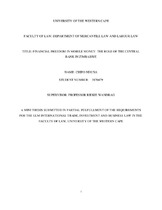Financial freedom in mobile money: the role of the central bank in Zimbabwe
| dc.contributor.advisor | Wandrag, Riekie | |
| dc.contributor.author | Nduna, Chipo | |
| dc.date.accessioned | 2020-12-02T10:47:56Z | |
| dc.date.available | 2020-12-02T10:47:56Z | |
| dc.date.issued | 2020-04-19 | |
| dc.identifier.uri | http://hdl.handle.net/11394/7624 | |
| dc.description | Magister Legum - LLM | en_US |
| dc.description.abstract | This paper analyses how the Zimbabwean economic history has led to the perception and attitude of the population towards the financial industry. It has been blighted by extremes to the extent that in 2008 the Zimbabwe economy had one of the highest hyperinflation rate in the world.1 Pettinger sums up the hyperinflation journey of Zimbabwe as having begun in the 1990s shortly after the disastrous land reform.2 This is where private farms were grabbed from landowners and re-allocated to mostly peasant farmers who had no technical know-how in farming. It was also a time when the country was involved in an unbudgeted and unsolicited second Congo civil war necessitating that the Government increase salaries to cater for soldiers and other officials assigned to the Congo.3 Earlier on the government had buckled under pressure from former war liberators (war veterans) and paid out unbudgeted bonuses.4 | en_US |
| dc.language.iso | en | en_US |
| dc.publisher | University of the Western Cape | en_US |
| dc.subject | Agents | en_US |
| dc.subject | Consumer protection | en_US |
| dc.subject | E-float | en_US |
| dc.subject | E-money | en_US |
| dc.subject | E-wallet | en_US |
| dc.subject | Eco-cash | en_US |
| dc.subject | Financial regulation | en_US |
| dc.subject | M-Pesa | en_US |
| dc.subject | Mobile money | en_US |
| dc.subject | Mobile Network Operators | en_US |
| dc.subject | Money transfer | en_US |
| dc.subject | Unbanked | en_US |
| dc.title | Financial freedom in mobile money: the role of the central bank in Zimbabwe | en_US |
| dc.rights.holder | University of the Western Cape | en_US |

